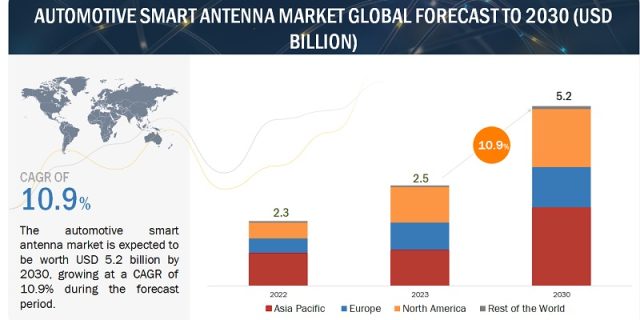
The global automotive smart antenna market is estimated to grow from USD 2.5 billion in 2023 to USD 5.2 billion by 2030, at a CAGR of 10.9%.
The increased demand for connected car features, in-vehicle infotainment, autonomous vehicles, and safety norms has increased the adoption of smart antennas globally. The smart antennas also provide high-speed, low-latency communication and real-time data exchange, making them suitable for the upcoming 5G technology.
Very High-frequency smart antennas are projected to showcase the highest demand over the forecast period.
The very high frequency ranges between 800 MHz and 2000 MHz. This frequency band is commonly used for various wireless communication services, including mobile networks (2G, 3G, 4G/LTE, and 5G), GPS, and other wireless applications. Navigation-related features are prominent and leading applications in the automotive sector. The growing concerns over traffic congestion and features like finding the best routes have made car navigation widely accepted globally. With the increased number of embedded systems, cars equipped with in-built navigation systems are growing globally. Today, navigation has become a necessary feature of vehicles.
Many countries have restricted the usage of overseas satellite navigation systems due to security reasons. Hence, a smart antenna for navigation systems needs to support GPS of respective countries such as GALILEO by Europe, GLONASS by Russia, BeiDou by China, QZSS by Japan, and IRNSS & Navigation with Indian Constellation (NAVIC) by India. Additionally, conventional cellular connectivity is expected to make the segment the largest in the automotive smart antenna market. Companies like TE Connectivity, Hirschmann, Telex, and Stratocell offer very high-frequency antennae for premium vehicles.
Compared to higher frequencies, these bands offer better penetration through buildings, foliage, and other obstacles, crucial for reliable connectivity in urban and rural environments. The increasing integration of advanced features in SUVs and premium vehicles, such as infotainment systems, telematics, navigation systems, and connectivity services, contributes to the need for more sophisticated antennas. Hence, the 800 MHz to 2000 MHz frequency range is crucial for various applications in automotive smart antennas, offering a balance between range, data capacity, and established technology, holding the largest market share in the frequency segment.
Download PDF Brochure @ https://www.marketsandmarkets.com/pdfdownloadNew.asp?id=29612374
ECU is the fastest-growing component for the automotive smart antenna market
The ECU is an alliance of electronic components with internal pre-programmed and programmable chipsets used to control one or more units in a vehicle. With the advent of intelligent cars, the automotive sector is moving toward a connected future. The ECU of a smart antenna includes hardware and software components that perform diverse functions for communication. As connected cars and autonomous driving technologies evolve, ECUs will become even more critical. They will handle advanced data processing, decision-making, and communication protocols, making them the driving force behind smart antenna performance and capabilities.
Smart antennas often require dedicated ECUs for managing antenna functions like signal processing, data routing, and communication with other systems. These ECUs integrate seamlessly into the overall E/E architecture, facilitating efficient data flow and optimal antenna performance. The Smart antennas rely on communication with other ECUs and the overall E/E architecture to access vehicle data like GPS location, V2X communication, Advanced Driver-Assistance Systems (ADAS), and dynamically adjust to optimize antenna performance in challenging environments.
Key players actively invest in R&D to manufacture ADAS and autonomous driving features, which require powerful vehicle ECUs. These advancements rely on powerful ECUs within smart antennas for data processing and communication.
Asia Pacific to be the fastest-growing automotive smart antenna market.
The Asia Pacific region stands out as the fastest-growing market for automotive smart antennas, propelled by several key factors. The region has witnessed a surge in automotive production and sales, with a growing demand for connected and technologically advanced vehicles. Countries like China, Japan, and India are the fastest-growing markets in the APAC region, with high sales of SUVs and premium vehicles. According to MarketsandMarkets analysis, the Asia Pacific region had a sales growth from 39.1 million vehicles in 2021 to 44.7 million in 2023 for the key countries. Also, consumers are highly seeking enhanced connectivity features, and the automotive OEMs in the Asia Pacific are actively incorporating smart antenna systems to meet these demands. Automakers like MG India with their vehicle Hector 2023 model have offered rear seat entertainment unit, online navigation, in-car infotainment system, ADAS, TPMS, 360-degree camera, cellular connectivity, remote vehicle control, over-the-air (OTA) updates, etc.
Key Players
Major manufacturers in the automotive smart antenna market include Continental AG (Germany), Denso Corporation (Japan), TE Connectivity (Switzerland), Forvia (France), and Ficosa Internacional SA (Spain).
Request Free Sample Report @ https://www.marketsandmarkets.com/requestsampleNew.asp?id=29612374

